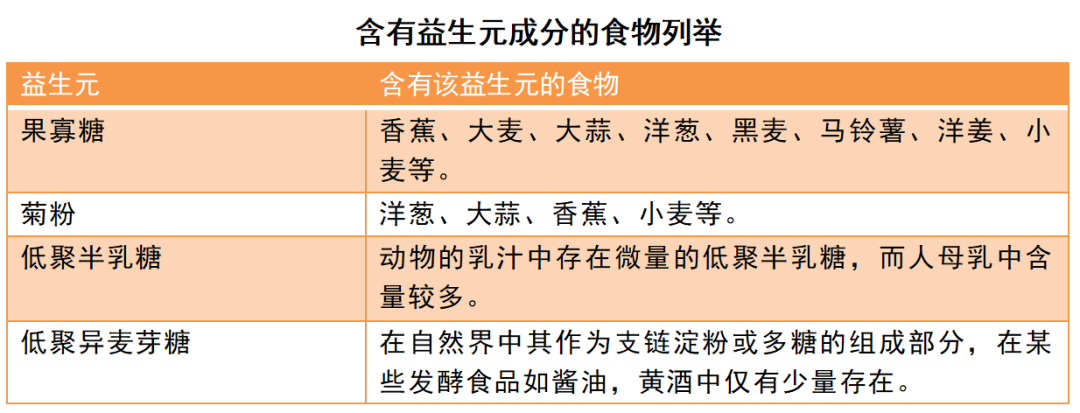我们日益了解到肠道菌群对于人类健康的重要性,而营养干预有助于建立或维持一个健康的肠道微生态。2020年《科学》综述发表调节肠道菌群的三种策略:分别是饮食和益生元(prebiotic)、益生菌(probiotic)和活性生物制品、粪便菌群移植(FMT)。
2021年中国营养学会益生菌益生元与健康分会发布的《益生元与健康科学专家共识》概要中,“益生元”特指“一般不能被人体所消化吸收但可被人体微生物选择性利用,能够改善肠道微生物组成和/或活性从而益于人体健康的食物成分”。了解益生元的特征属性标签,我们才能“鉴别”什么是益生元。益生元的标签主要由两个:一个是“物质”属性,一个是“健康”属性。
标签1:“物质属性”
益生元不是微生物或者药物
虽然益生元的定义没有限定益生元必须属于碳水化合物,比如不溶于水的可可粉(多酚)也证实可以显著增加双歧杆菌、乳酸杆菌和丁酸的产生,发挥益生元的作用。但目前得到深入研究和广泛应用的益生元几乎都是碳水化合物。包括各种多糖、低聚糖和糖醇,如菊粉、低聚果糖、低聚半乳糖、聚葡萄糖、β-葡聚糖、抗性糊精和乳果糖等。
益生元可以进行化学定性和定量分析
人们通过定性定量分析益生元来研究其对益生菌的影响,大部分益生元都通过高效液相色谱法(HPLC)、离子交换色谱法(IC)、质谱法(MS)、酶联免疫吸附试验(ELISA)、分光光度法等方法进行定性定量分析。
益生元通常是一种食物成分
益生元通常是一种食物成分,但不能被小肠消化吸收。一般来讲,益生元在人体胃和小肠内不被消化吸收而进入大肠作为肠道细菌发酵的碳源。

可以是某类膳食纤维但不等同于膳食纤维
益生元和膳食纤维是相互关联但不尽相同的概念。不溶性膳食纤维通常被假定为益生元,因为只有当他们能够促进有益细菌的生长,发挥健康作用时才能被归类为真正的益生元。
标签2:“健康属性”
益生元依赖微生物代谢,能够选择性刺激益生菌,从而消除与细菌竞争的需要,可被人体微生物选择性利用而对宿主产生健康的作用。尽管许多特定物质也可被微生物分解利用,但如果这种作用不能给宿主带来健康益处,这种物质也不能被称为益生元。益生元不被宿主酶消化,以几乎不变的形式到达结肠,在结肠中由解糖细菌(如双歧杆菌)发酵。益生元的摄入在很大程度上影响了肠道微生物群的组成及其代谢活性。益生元对机体健康的有意作用包括:防御病原体、调节免疫、增加矿物质吸收、改善肠道功能、调节代谢以及影响饱腹感。
参考文献:
[1]Jennifer A. Wargo (2020) Modulating gut microbes. Science Doi: 10.1126/science.abc3965
[2]Gibson GR, Hutkins R, Sanders ME, et al. Expert consensus document: The International Scientific Association for Probiotics and Prebiotics (ISAPP) consensus statement on the definition and scope of prebiotics. Nat Rev Gastroenterol Hepatol. 2017 Aug;14(8):491-502.
[3]Sanders ME, Merenstein DJ, Reid G, et al. Probiotics and prebiotics in intestinal health and disease: from biology to the clinic. Nat Rev Gastroenterol Hepatol. 2019 Oct;16(10):605-616. doi: 10.1038/s41575-019-0173-3. Epub 2019 Jul 11. Erratum in: Nat Rev Gastroenterol Hepatol. 2019 Aug 9;: PMID: 31296969.
[4]Davani-Davari D, Negahdaripour M, Karimzadeh I, et al. Prebiotics: Definition, Types, Sources, Mechanisms, and Clinical Applications. Foods. 2019 Mar 9;8(3):92. doi: 10.3390/foods8030092. PMID: 30857316; PMCID: PMC6463098.
[5]Gibson, G. R. & Roberfroid, M. B. Dietary modulation of the human colonic microbiota: introducing the concept of prebiotics. J. Nutr. 125, 1401–1412 (1995).
[6]Gibson, G. R. et al. Expert consensus document: The International Scientific Association for Probiotics and Prebiotics (ISAPP) consensus statement on the definition and scope of prebiotics. Nat. Rev. Gastroenterol. Hepatol. 14, 491–502 (2017). This Consensus Statement examines the definition, evolution, uses, types and health attributes of prebiotics.
[7]Salminen S, Collado MC, Endo A, et al. The International Scientific Association of Probiotics and Prebiotics (ISAPP) consensus statement on the definition and scope of postbiotics. Nat Rev Gastroenterol Hepatol. 2021 May 4. doi: 10.1038/s41575-021-00440-6. Epub ahead of print. PMID: 33948025.
[8]Markowiak P, Śliżewska K. Effects of Probiotics, Prebiotics, and Synbiotics on Human Health. Nutrients. 2017 Sep 15;9(9):1021.
[9]´Sli˙ zewska, K.; Nowak, A.; Barczy ´ nska, R.; et al.˙Zywno´ s´ c Nauka T echnologia Jako´ s´ c 2013, 1, 5–20.
[10]Crittenden, R.; Playne, M.J. Nutrition News. Facts and functions of prebiotics, probiotics and synbiotics. In Handbook of Probiotics and Prebiotics; Lee, Y .K., Salminen, S., Eds.; Wiley-Interscience, Kansas State University: Hoboken, NJ, USA; Manhattan, KS, USA, 2008; pp. 535–582.
[11]Gibson, G.R.; Probert, H.M.; van Loo, J.; et al. Dietary modulation of the human colonic microbiota: Updating the concept of the prebiotics. Nutr. Res. Rev. 2004, 17, 259–275.
作者:杨敏 | 中国营养学会益生菌益生元与健康分会 浙江省农业科学院
审稿:李小琼 | 中国营养学会益生菌益生元与健康分会 浙江省农业科学院







 扫码下载APP
扫码下载APP

 科普中国APP
科普中国APP
 科普中国
科普中国
 科普中国
科普中国